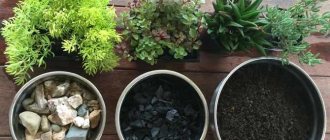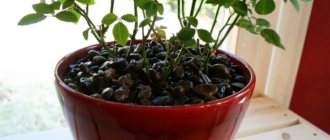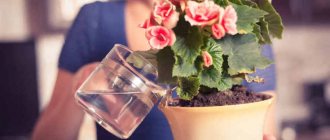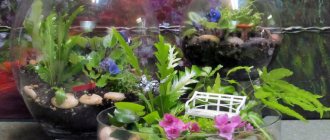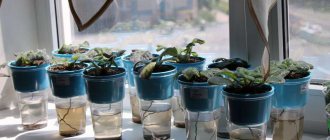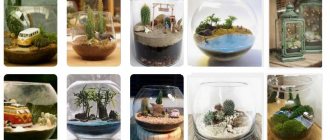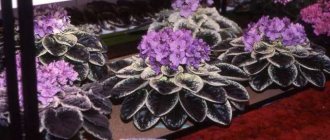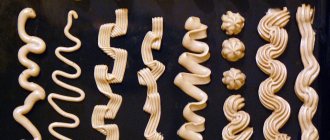There is not a single indoor plant that can be grown without drainage. Even the most moisture-loving crops that are not afraid of dampness still require a special layer to be placed at the bottom of the containers when planting and replanting. And you cannot do without drainage, which is responsible for the water permeability and breathability of the soil, the effective distribution and outflow of water, no matter what substrate you use. Creating comfortable conditions begins with the correct choice of drainage system. And not only the materials themselves play a role, but also the height of the layer.
Drainage for indoor plants. © praisaeng
What is drainage for indoor plants and why are drainage holes needed in a flower pot?
Drainage refers to both the process and the material by which excess water is removed from the soil in which a houseplant grows.
In closed-type plant growing, that is, when an indoor flower is planted directly in a pot, a permeable material is placed on the bottom of the container, which allows you to get rid of excess moisture by removing it directly through the drainage holes in the pot.
To ensure proper drainage, the following conditions must be met when planting or replanting an indoor flower:
- You can plant flowers in a pot only if a suitable type of drainage is laid at the bottom, to a height of no less than 1/6 of the total height of the container.
- The minimum height of the layer that will ensure moisture removal is 1 cm. Otherwise, the system turns out to be ineffective or ineffective at all.
- The material must be placed at the bottom of the container in a dry state immediately before the planting process is carried out.
But it is worth considering that drainage can be either purchased in a specialized store or made from improvised substances. In the first case, you should study the instructions on the packaging in detail, since some types of material require pre-soaking before the planting process.
To simplify the process of caring for some plants, especially in cases where the owners need to leave for a certain period of time, a special pot with a drainage system is used. This is also a great option for those who do not yet have much experience in home gardening.
Other elements of the drainage system
In addition to the layer of bulk materials, the drainage system should also include:
- drainage holes of the container itself;
- loosening additives to the substrate, which give it a light, loose texture, prevent the soil from becoming excessively compacted.
They function in the same system and are equally important to ensure optimal conditions. When growing hydroponically, drainage completely replaces the growing substrate; in fact, the entire technology is drainage.
But even in hydroponics, the drainage holes of the container do not lose their importance, because even with an ideal drainage layer, insufficient outflow of water from the container itself will negate all efforts.
Pots and various flowerpots, no matter how attractive and stylish they are, must have at least one drainage hole. But usually the optimal size and number of holes are selected for each plant and each container individually
In plastic or polymer pots it is easy to make holes yourself, but when purchasing ceramic and terracotta pots you need to evaluate the drainage capabilities of the pots more carefully. Any container for indoor plants requires drainage holes that will allow water to drain freely, will not become clogged with soil and roots, but will also prevent the substrate and drainage fragments from falling out of the pot.
The minimum dimensions for holes for water drainage are from 0.5 cm. Holes larger than 1 cm must be covered with a mesh. But choosing the quantity is more difficult: for tall containers you need 5 evenly distributed holes, which will allow the soil to dry out evenly in the lower part, and for wide and low pots one large hole is enough. For orchids and other epiphytes, “leaky” pots are chosen, with numerous holes in the bottom and walls.
Make holes in the bottom of the pot to allow water to drain. © purple sprout
Lay out the required drainage layer. © purple sprout
Fill the remaining volume of the pot with soil. © purple sprout
What materials are suitable for arranging drainage
When preparing to plant a houseplant, it is worth considering that it is not necessary to buy expanded clay or other drainage material. It can be taken from scrap materials or some natural components. Let's try to consider all the options for creating the correct planting method and what can be used from available means to achieve the required level of drainage.
Expanded clay for flowers
Expanded clay is most often used to create the required level of drainage. It can be purchased at specialized gardening stores.
The material consists of small lumps of clay. But their distinctive features are that they have a fairly porous structure and low weight. Today there are several categories of expanded clay on sale, each of which differs in the size of the lumps. So, there are varieties with a diameter not exceeding 5 mm, and there are also especially large ones - up to 2 cm.
Before using expanded clay, you need to make sure that its size will be larger than the size of the drainage holes. Otherwise, it will fall out of the pot when rearranging the flower.
Crushed stone, pebbles and gravel
You can personally store pebbles or small pebbles in the form of gravel or crushed stone from the river coast. True, they should be divided by size in order to obtain a fairly uniform drainage material. In addition, the following manipulations must be carried out over river pebbles or gravel:
- Pre-sort out any loose debris.
- Rinse thoroughly under running water.
- It is also advisable to pour boiling water over it or bake it in the oven to carry out the disinfection process.
This is done to ensure that the soil mixture does not contain any pathogenic bacteria, spores or fungi, as well as infections that could negatively affect the life of the house plant.
This drainage can be used several times. But of course, if the pebbles are to be reused, they must also be disinfected.
Broken brick
If you don’t want to buy drainage material from stores, and you have brick or its fragments on your farm, you can use them for potted plants. A whole brick can be crushed into small pieces of the desired size. And when small fragments are obtained or this is already a breakage from the building material, its sharp edges should be rounded so that the root system of the plant is not damaged by them.
It should be noted that clay brick shards are best suited for those plants that accumulate moisture in the foliage and trunk, as well as for succulents. In this case, you can do without special drainage holes at the bottom of the pot.
Ceramic shards
In any home there is a battle of dishes. It can be saved up first and then used to pour it into the bottom of the pot as drainage.
Due to the fact that such ceramic ware fragments have a high density and hardness, but are also porous enough to absorb moisture, they are able to prevent the soil from drying out. In addition, they can be used for a long time by placing them several times in flower pots. But do not forget to disinfect when reusing.
Coconut fiber
From natural materials, coconut fibers can be used in pots. Their advantages are as follows:
- Coconut fibers are able to quite intensively accumulate water and retain it for a long time.
- This is an environmentally friendly material that has an optimal acid-base balance for indoor plants.
- In addition, coconut raw materials can nourish the soil with additional micro and macroelements, which can be used as additional fertilizing.
- It takes a long time to decompose, so you can forget about drainage in the pot for about 5 years.
Charcoal
To use charcoal as drainage for plants, you can purchase regular fuel sold for grilling. One that is made from birch or aspen wood is suitable.
Thanks to charcoal, you can avoid the process of soil acidification and also increase its level of looseness.
Eggshell
You can also make drainage for indoor plants from shells collected from ordinary chicken or quail eggs.
To do this, perform the following steps:
- Collect egg shells. Be sure to remove the inner film, which can adhere quite tightly to the surface.
- It is desirable that the pieces are large enough. Otherwise, small parts will simply fall through the hole in the bottom of the pot.
- After this, you need to rinse the collected shells under running water. You can also pour boiling water over it in order to get rid of all organic parts that are capable of rotting.
- After this, the shell is intensively tapped. You can do this in direct sunlight, or you can place it in the oven at low temperature, for about 15-20 minutes.
It is important to keep all these manipulations completed before creating the drainage process in the flower pot. Otherwise, if the shell is not processed intensively enough, it can lead to damage to the roots due to the process of rotting.
Another added benefit of using eggshells is the ability to enrich the soil with certain minerals, including calcium.
Perlite and vermiculite
Elements such as perlite and vermiculite, which are made from obsidian hydroxide or hydromica, respectively, can loosen the soil, create a level of drainage, and also increase the aeration of the soil mixture. They are laid out on the bottom at the required thickness.
But, it should be taken into account that perlite needs to be changed 3 years after the start of use, since it deteriorates quite intensively.
Sphagnum moss
In cases where it is necessary not only to ensure the required level of drainage, but also to enhance the antiseptic parameters of the soil, sphagnum moss should be used. You can collect it yourself by going to a marshy area in mid-autumn. After it is collected, it is dried.
If you don’t want to bother with collecting sphagnum moss, you can purchase it in specialized stores.
But, before using this remedy, you should note that moss must be used simultaneously with charcoal. These two materials cover approximately 25% of the total height of the pot.
Foam drainage
Despite the fact that this drainage option is not very successful, you can still use polystyrene foam to solve the problem of excessive moisture removal.
This is an easy, cheap and quite effective method, which, however, is not environmentally friendly.
Also, inexperienced gardeners should immediately take into account that drainage for indoor flowers made of polystyrene foam is best used for those crops of house plants that often need replanting. Otherwise, the roots will grow into white balls.
Sea or aquarium stone
Stone collected from the sea coast can also be used for these purposes. But it must be taken into account that before you put it in the soil, you need to get rid of the surface salt. This is achieved by repeated boiling.
Otherwise, the plant will simply be ruined, since excessive amounts of salt will enter the soil.
So what is the need for drainage?
The health of indoor plants directly depends on the presence of drainage.
Many types of flowers simply cannot tolerate the presence of constant moisture in the root system, and some may die from excess moisture. So most flowers require that the soil composition be 15% air, 35% water and 50% solid particles. That is why it is necessary to provide special drainage, which can help create optimal conditions for the flower.
Excessive watering displaces the 15% of air that plants need so much. In an environment without oxygen, harmful bacteria begin to develop. This contributes to the rotting of the roots and the flower itself withers. Drainage is simply necessary, since this is the only way that excess water can escape and the roots of the plant can breathe.
Lilac planting and care - what do you know about it?
What climbing plants can be used to cover a gazebo? The answer is here.
How to properly install drainage
In order for drainage for indoor flowers to fulfill its main purpose - to remove excess water introduced into the soil and thus prevent the process of rotting, the following rules should be taken into account:
First you need to disinfect the container in which the plant will be planted.
Then the same disinfection manipulation is carried out in relation to the drainage. It is either doused with boiling water or kept in the oven for a fairly long period of time (about 15-20 minutes). This calcination allows you to get rid of possible infections and parasites and prevent infection of your indoor plant. It is important to understand that such manipulations are carried out only when drainage for indoor plants is done with your own hands. If store-bought mixtures are purchased, then, as a rule, they do not require additional processing.
After this, drainage material is laid out at the bottom at the required height. The soil mixture is poured on top, a depression is made in it and a houseplant is planted.
Functions and features of drainage?
Excessive moisture leads to soil acidification and creates an environment for the development of dangerous bacteria. Proper distribution of moisture is only possible with drainage. It promotes normal water outflow and creates soil breathability. Without these functions, proper development of the plant is impossible. The soil drainage system allows you to maintain the required level of substrate moisture. It is made from large elements poured into the bottom of the container. Thanks to the presence of voids between them, conditions are created for the proper outflow of water. In addition, the air exchange function of the layer provides the roots with the necessary oxygen. For cacti, succulents and some other types of plants, it is necessary to ensure rapid drainage of moisture. It is impossible to do this without a special layer under the substrate.
Is it possible to do without a drainage layer?
There are situations when you can do without a drainage layer. But it should be borne in mind that the plant still needs to provide the required level of aeration and moisture removal. For these purposes you can use:
- A pot with automatic watering, where the irrigation process will be carried out automatically , and the drainage system has already been thought out.
- You can also use a pot with a drainage system.
Using expanded clay for flower drainage
Expanded clay is baked clay with a porous structure; it can be purchased at all flower shops.
Expanded clay is also used in construction as insulation and soundproofing material. The medium and small fractions are often used in floriculture.
For large plants, expanded clay of the middle fraction is selected - up to 2 cm in diameter. A layer of sand is poured on top.
The shelf life is 5-6 years, after which it turns into soil, so it needs to be changed periodically.
The main advantage is not only the removal of excess moisture, but also the absorption of it.
Phalaenopsis orchid and its care - detailed instructions.
What is the use of horizontal cotoneaster on the site? Read the answer.
Description of the Variegated Deren - how to plant, care, prune - https://greennirvana.ru/rasteniya/kustarniki/deren-pestrlistniy.html
Manufacturing errors and what should not be used as drainage
Some inexperienced indoor gardeners make mistakes when planting plants. The point is that you need to know what height the drainage layer needs to be created, and also what materials cannot be used for such purposes.
Use should be avoided:
- Sand, as it is too dense and can be compressed.
- Marble chips, since they can radically change the acid-base parameters of the soil.
- Also, some natural materials, such as tree bark or walnut shells, are undesirable from the point of view of laying them on the bottom of the pot. The fact is that they are capable of rotting, thereby spreading putrefactive processes to the root system of the plant, which can lead not only to growth inhibition, but also to death.
What can it be made from?
Let's list a list of materials suitable for creating a drainage system and find out which one is better and how to prepare them correctly. Florists usually use the following as drainage materials:
- Ceramics . Old ceramic pots can be used to build drainage. It is enough to split them into small shards and disinfect them. The fragments are placed at the bottom of the pot with the convex part up. They shouldn't be too large. The downside is the presence of sharp edges.
- Expanded clay . This is one of the best and inexpensive drainage materials. It easily removes moisture and also absorbs it, giving it to the plant as needed. Expanded clay drainage does not have sharp corners, and therefore it is safe for the root system. However, it needs to be disinfected before use. No cons noted.
- Moss . Sphagnum moss can be collected from a swamp or bought at a flower shop. This is not only a drainage material, but also a good disinfectant and moisture-retaining agent. Before laying on the bottom, it must be soaked for 30 minutes in warm water. The downside is the fragility. But given that plants require frequent replanting, this is not a problem. Another drawback is that the roots grow through the moss. Therefore, it will be almost impossible to separate them from each other in the future.
- Charcoal . This is not only drainage, but also fertilizing, as well as a moisture-retaining agent and material that absorbs salts and disinfects the soil. Coal is placed on the bottom of the pot in large pieces. There are no cons. But there is a nuance - it alkalizes the soil. And this is harmful if the plant prefers a slightly acidic or acidic soil reaction.
- Vermiculite . It absorbs water along with nutrients. Therefore, the plant will be fed every time the material begins to release moisture. There are no cons.
- Perlite . This is another one of the best materials for creating drainage. But it's expensive. Perhaps this is its only drawback.
